
Local government is a generic term for the lowest tiers of public administration within a particular sovereign state. This particular usage of the word government refers specifically to a level of administration that is both geographically-localised and has limited powers. While in some countries, "government" is normally reserved purely for a national administration (government), the term local government is always used specifically in contrast to national government – as well as, in many cases, the activities of sub-national, first-level administrative divisions. Local governments generally act only within powers specifically delegated to them by law and/or directives of a higher level of government. In federal states, local government generally comprises a third or fourth tier of government, whereas in unitary states, local government usually occupies the second or third tier of government.

A district is a type of administrative division that, in some countries, is managed by the local government. Across the world, areas known as "districts" vary greatly in size, spanning regions or counties, several municipalities, subdivisions of municipalities, school district, or political district.
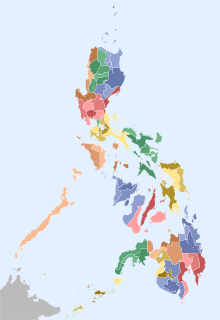
In the Philippines, provinces are one of its primary political and administrative divisions. There are 81 provinces at present, which are further subdivided into component cities and municipalities. The local government units in the National Capital Region, as well as independent cities, are independent of any provincial government. Each province is governed by an elected legislature called the Sangguniang Panlalawigan and an elected governor.
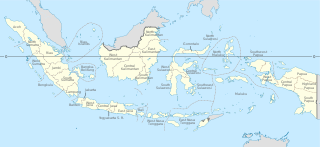
Provinces of Indonesia are the 37 administrative division of Indonesia and the highest tier of the local government. Provinces are further divided into regencies and cities, which are in turn subdivided into districts (kecamatan).
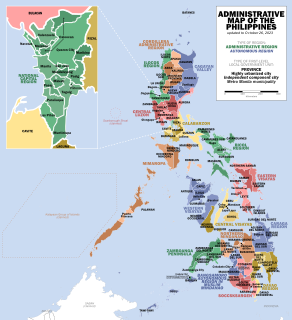
In the Philippines, regions are administrative divisions that primarily serve to coordinate planning and organize national government services across multiple local government units (LGUs). Most national government offices provide services through their regional branches instead of having direct provincial or city offices. Regional offices are usually but not necessarily located in the city designated as the regional center.

A city is one of the units of local government in the Philippines. All Philippine cities are chartered cities, whose existence as corporate and administrative entities is governed by their own specific municipal charters in addition to the Local Government Code of 1991, which specifies their administrative structure and powers. As of September 7, 2019, there are 146 cities.
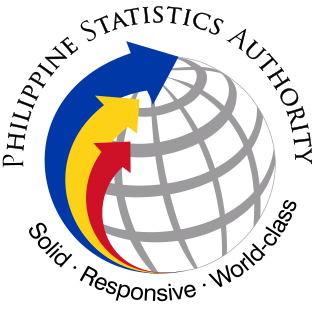
The Philippine Statistics Authority, abbreviated as PSA, is the central statistical authority of the Philippine government that collects, compiles, analyzes and publishes statistical information on economic, social, demographic, political affairs and general affairs of the people of the Philippines and enforces the civil registration functions in the country.
The Philippines is divided into four levels of administrative divisions with the lower three being defined in the Local Government Code of 1991 as local government units (LGUs). They are, from the highest to the lowest:
- Regions, mostly used to organize national services. Of the 17 regions, only one – the Bangsamoro Autonomous Region in Muslim Mindanao – has an elected government to which the central government has devolved competencies.
- Provinces, independent cities, and one independent municipality (Pateros).
- Component cities and municipalities within a province.
- Barangays within a city or municipality.
The Union of Local Authorities of the Philippines (ULAP) is the umbrella organization of all leagues of local government units (LGUs) and locally elected government officials, and was formed in 1998, registered in 1999, and further endorsed through Executive Order 351, series of 2004.
Sangguniang Panlalawigan, commonly known as the Provincial Board, are the legislatures in Philippine provinces. They are the legislative branches of the provinces, and their powers and responsibilities are defined by the Local Government Code of 1991. Along with the provincial governor, the executive branch of the province, they form the province's government.
The local government in the Philippines is divided into three levels: provinces and independent cities, component cities and municipalities, and barangays, all of which are collectively known as local government units (LGUs). In one area, above provinces and independent cities, is an autonomous region, the Bangsamoro Autonomous Region in Muslim Mindanao. Below barangays in some cities and municipalities are sitios and puroks. All of these, with the exception of sitios and puroks, elect their own executives and legislatures. Sitios and puroks are often but not necessarily led by an elected barangay councilor.

The Romblon Provincial Federation of Sangguniang Kabataan(PFSK) is the official association of elected Sangguniang Kabataan presidents in the province of Romblon. It is composed of eighteen (18) members; seventeen (17) Municipal Sangguniang Kabataan Federation President and one (1) Provincial SK Federation President. It is their thrust to conduct and implement programs that would improve the youth of Romblon socially, intellectually, spiritually, politically, and morally to be dynamic, productive, and effective citizens and future leaders of the province of Romblon and the republic as a whole.

The Liga ng mga Barangay sa Pilipinas and the Asosasyon ng mga Kapitan ng Barangay or ABC are formal organizations of all the barangays in the Philippines. Presently, almost 42,000 barangays are part of this organization, making it the association of Philippine local government units with the largest membership.

The League of Municipalities of the Philippines - or more simply the League of Municipalities or LMP - is a formal organization of all the municipalities in the Philippines. Presently, sixty eight municipalities are part of this organization.

The League of Cities of the Philippines (LCP), also known simply as the League of Cities, is a formal organization of all cities in the Philippines. As of September 7, 2019, there are 146 cities which are part of the organization.

Bellaflor "Bella" Javier Angara-Castillo, simply known as Bella Angara, is a former member of the Philippine House of Representatives representing the lone district of Aurora. She previously served three consecutive terms as governor of Aurora province from 2004 to 2013. She was the third female governor of Aurora province. Prior to being governor, she served three consecutive terms as representative of the lone district of Aurora from 1995 to 2004. She was the first and so far the only woman in the history of the Philippine Congress to become House majority floor leader.

Regina Ongsiako Reyes-Mandanas was a member of the Philippine House of Representatives representing the lone legislative district of Marinduque. She was the youngest daughter of former Bureau of Immigration Commissioner Edmundo Reyes, Sr. and Marinduque Governor Carmencita O. Reyes. She was also the wife of incumbent Batangas Governor Hermilando Mandanas.

Ramil Laurel Hernandez is a Filipino politician from Calamba City, Laguna. He currently serves as the Governor of Laguna since 2014. He previously served as Sanguniang Kabataan Chairman of Barangay Mabato in Calamba, Laguna, a councilor of Calamba, a board member, and Vice Governor of Laguna. He was elevated to Governor following the disqualification of E.R. Ejercito in 2014. He was first elected as Governor in 2016 and was re-elected in 2019 and 2022.
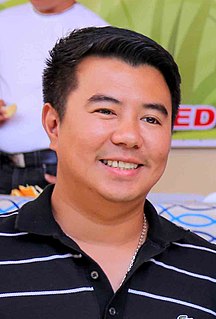
Ryan Luis Verzosa Singson is a Filipino politician from the first district of Ilocos Sur. He is currently serving as the Governor of Ilocos Sur. Singson was elected three terms as a Governor of Ilocos Sur. He was first elected as a Governor in 2013 and was re-elected in 2016 and 2019.















